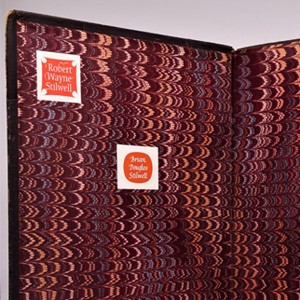Related Information
In the context of rare bookselling, provenance refers to the history of a book’s ownership and the documentation of its past. John Carter referred to provenance as the “pedigree of a book’s previous ownership.”
This information is important because it can provide context, support the authenticity of any author's signature or inscription, and generally add to our understanding of the copy in question. At another level, provenance establishes a chain of title that determines whether the book in question can legally be re-sold.
Determining Provenance
A book may contain bookplates or stamps indicating ownership, dates indicating when or where purchased and by whom, handwritten annotations, names or inscriptions — either by the author or a person gifting the book to another. Books might also be bound or rebound in distinctive bindings once favored by wealthy connoisseurs.
Booksellers may also consult auction and/or catalog records to determine if or when a book has been sold or offered for sale in the past, and thus demonstrate the book’s value and further verify its ownership over time.
If a book is signed or inscribed by the author, the question arises to whom the book was signed: was this a person with whom the author had a specific bond or connection, or was this simply a fan waiting in line to have the author sign their book? This relationship between the author and the book’s owner can have a profound impact on the desirability of the book to collectors or institutions. ABAA-member Ken Lopez explains the established hierarchy of values pertaining to books signed by their authors thusly:
“The best copy was the 'dedication copy,' and usually there was only one of these. Next best were 'association copies,' that is, books inscribed by the author to someone notable or important in the author's life -- a relative, a friend, a mentor, another writer. After that were 'presentation copies,' which simply meant those books inscribed by the author to someone who was not important to the author, or whose importance was unknown. And finally, at the bottom of the hierarchy, were books that were just signed, with no further inscription, no other writing, etc."
Examples:
De Revolutionibus Orbium Coelestium, Libri VI
by COPERNICUS, Nicolaus
![]()
1543. 147 woodcut diagrams in the text. 6 p.l., 196 leaves. Small folio (272 x 190 mm.), cont. Parisian binding of light brown calf (very skillful restorations to the binding), panelled in blind with gilt fleurons in the corners, gilt floral tool in the center of each cover of a hand holding flowers, small gilt stars in the six compartments of spine. Nuremberg: J. Petreius, 1543.
First edition, and a very fine and crisp copy, of “the earliest of the three books of science that most clarified the relationship of man and his universe (along with Newton’s Principia and Darwin’s Origin of Species).”–Dibner, Heralds of Science, 3. This work is the foundation of the heliocentric theory of the planetary system and the most important scientific text of the 16th century.
This is the seventh or eighth copy I have handled over the past 39 years. How does it compare to the others? Quite nicely. First of all, this is one of the largest copies extant; simply, this copy is really big. Also, I have had only one other copy in a 16th-century binding (Census I.245). Our binding, while carefully and skillfully repaired, is a very beautiful contemporary Parisian example; the tool of a hand holding flowers in the center of each cover is very similar to the one used on many of Marcus Fugger’s plain calf bindings. It is a lovely tool in general use by the Paris binders of the period 1550-1560. The endpapers have been renewed but they are not offensive. There is a small early erasure of an ownership inscription on the title just slightly touching the “D.” in the date. The first six leaves have some light dampstaining but it is pale.
Provenance: At the foot of the title-page, another early signature has been thoroughly lined through. 17th- or 18th-century ownership inscription on title: “Collegii Parisiensis Societat jesu.” —Bookplate of Gustavus Wynne Cook (1867-1940, amateur astronomer, collector, and benefactor of the Franklin Institute). —Franklin Institute Library bookplate. —Sold Sotheby Parke-Bernet, New York, 2 November 1977, lot 85, to the British Railway Pension Fund (a famously selective buyer). —Purchased by Pierre Berès at Sotheby’s London, 21 October 1980 and sold to a prominent Spanish private collector.
A very large, fresh, and crisp copy (the leaves “crackle”). Preserved in a morocco-backed box. Collation as in Horblit; some copies — about 20 per cent according to Prof. Gingerich — contain an errata leaf printed separately and later.
Offered by Jonathan A. Hill, Bookseller.
by Dureri, Alberti ( Albrecht Durer)
Monachii (Munich): J. B. Dreselly, 1838. Book. Very Good. Hardcover. First Edition. Folio - over 12" - 15" tall. RARE. No Date, circa 1838-39. Very Good, edges rubbed, boards lightly spotted, all edges gilt, marbled end papers, bookplates of Robert Wayne Stilwell and Brian Douglas Stilwell front paste down. Portrait frontispiece of Durer with pictorial title page, 43 leaves each containing the Lord's Prayer in a different language, surrounded by decorations by Durer in different colors and one leaf on stiff paper stock in green, red, and black with a rubricated passage from St. Luke. A RARE and valuable work of decorated lithography.
Offered by Dale Steffey Books.
